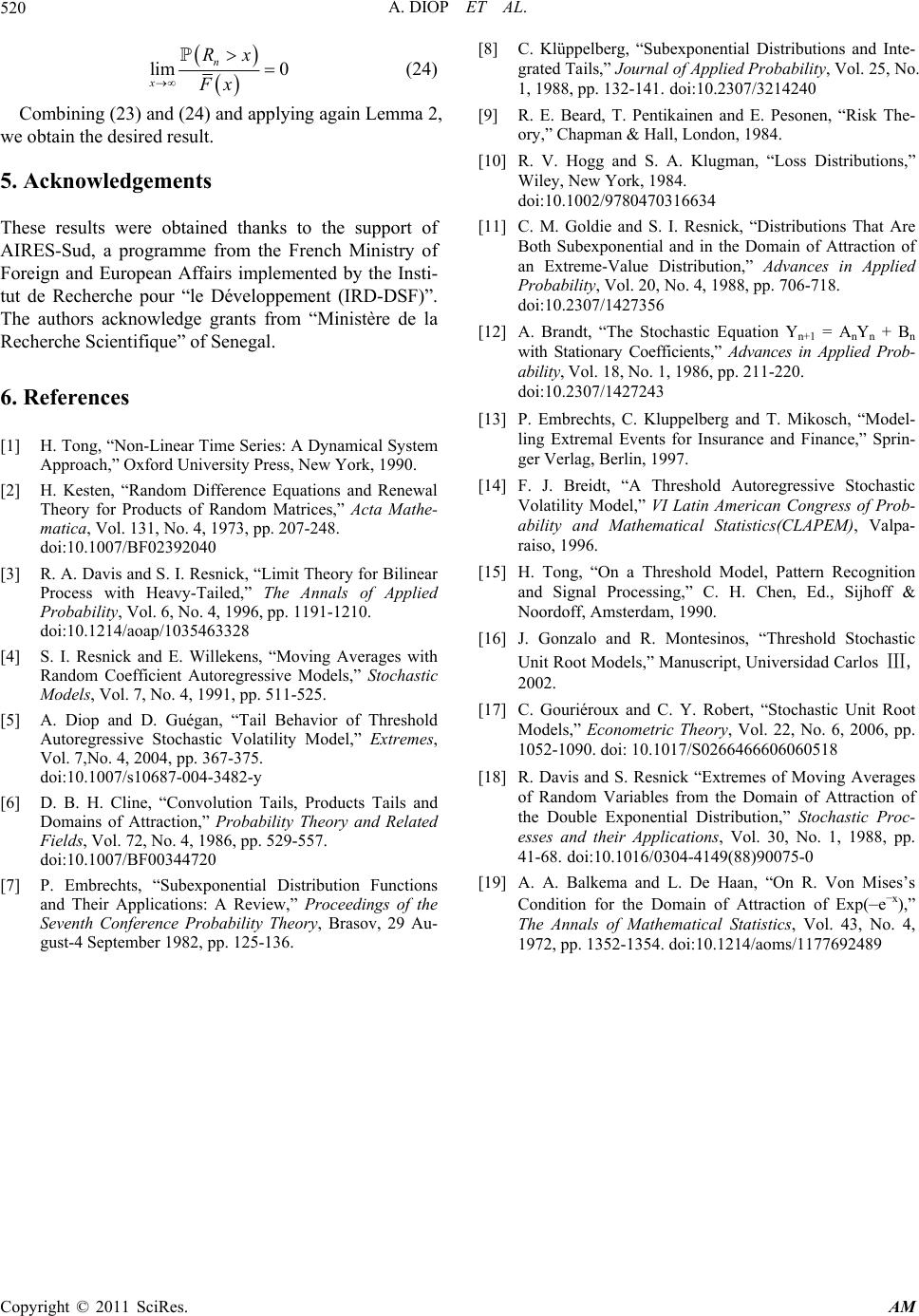
A. DIOP ET AL.
Copyright © 2011 SciRes. AM
520
lim 0
n
x
Rx
Fx
(24)
[8] C. Klüppelberg, “Subexponential Distributions and Inte-
grated Tails,” Journal of Applied Probability, Vol. 25, No.
1, 1988, pp. 132-141. doi:10.2307/3214240
Combining (23) and (24) and applying again Lemma 2,
we obtain the desired result.
[9] R. E. Beard, T. Pentikainen and E. Pesonen, “Risk The-
ory,” Chapman & Hall, London, 1984.
[10] R. V. Hogg and S. A. Klugman, “Loss Distributions,”
Wiley, New York, 1984.
doi:10.1002/9780470316634
5. Acknowledgements
These results were obtained thanks to the support of
AIRES-Sud, a programme from the French Ministry of
Foreign and European Affairs implemented by the Insti-
tut de Recherche pour “le Développement (IRD-DSF)”.
The authors acknowledge grants from “Ministère de la
Recherche Scientifique” of Senegal.
[11] C. M. Goldie and S. I. Resnick, “Distributions That Are
Both Subexponential and in the Domain of Attraction of
an Extreme-Value Distribution,” Advances in Applied
Probability, Vol. 20, No. 4, 1988, pp. 706-718.
doi:10.2307/1427356
[12] A. Brandt, “The Stochastic Equation Yn+1 = AnYn + Bn
with Stationary Coefficients,” Advances in Applied Prob-
ability, Vol. 18, No. 1, 1986, pp. 211-220.
doi:10.2307/1427243
6. References
[13] P. Embrechts, C. Kluppelberg and T. Mikosch, “Model-
ling Extremal Events for Insurance and Finance,” Sprin-
ger Verlag, Berlin, 1997.
[1] H. Tong, “Non-Linear Time Series: A Dynamical System
Approach,” Oxford University Press, New York, 1990.
[14] F. J. Breidt, “A Threshold Autoregressive Stochastic
Volatility Model,” VI Latin American Congress of Prob-
ability and Mathematical Statistics(CLAPEM), Valpa-
raiso, 1996.
[2] H. Kesten, “Random Difference Equations and Renewal
Theory for Products of Random Matrices,” Acta Mathe-
matica, Vol. 131, No. 4, 1973, pp. 207-248.
doi:10.1007/BF02392040
[15] H. Tong, “On a Threshold Model, Pattern Recognition
and Signal Processing,” C. H. Chen, Ed., Sijhoff &
Noordoff, Amsterdam, 1990.
[3] R. A. Davis and S. I. Resnick, “Limit Theory for Bilinear
Process with Heavy-Tailed,” The Annals of Applied
Probability, Vol. 6, No. 4, 1996, pp. 1191-1210.
doi:10.1214/aoap/1035463328 [16] J. Gonzalo and R. Montesinos, “Threshold Stochastic
Unit Root Models,” Manuscript, Universidad Carlos Ⅲ,
2002.
[4] S. I. Resnick and E. Willekens, “Moving Averages with
Random Coefficient Autoregressive Models,” Stochastic
Models, Vol. 7, No. 4, 1991, pp. 511-525.
[17] C. Gouriéroux and C. Y. Robert, “Stochastic Unit Root
Models,” Econometric Theory, Vol. 22, No. 6, 2006, pp.
1052-1090. doi: 10.1017/S0266466606060518
[5] A. Diop and D. Guégan, “Tail Behavior of Threshold
Autoregressive Stochastic Volatility Model,” Extremes,
Vol. 7,No. 4, 2004, pp. 367-375.
doi:10.1007/s10687-004-3482-y [18] R. Davis and S. Resnick “Extremes of Moving Averages
of Random Variables from the Domain of Attraction of
the Double Exponential Distribution,” Stochastic Proc-
esses and their Applications, Vol. 30, No. 1, 1988, pp.
41-68. doi:10.1016/0304-4149(88)90075-0
[6] D. B. H. Cline, “Convolution Tails, Products Tails and
Domains of Attraction,” Probability Theory and Related
Fields, Vol. 72, No. 4, 1986, pp. 529-557.
doi:10.1007/BF00344720
[19] A. A. Balkema and L. De Haan, “On R. Von Mises’s
Condition for the Domain of Attraction of Exp(–e–x),”
The Annals of Mathematical Statistics, Vol. 43, No. 4,
1972, pp. 1352-1354. doi:10.1214/aoms/1177692489
[7] P. Embrechts, “Subexponential Distribution Functions
and Their Applications: A Review,” Proceedings of the
Seventh Conference Probability Theory, Brasov, 29 Au-
gust-4 September 1982, pp. 125-136.